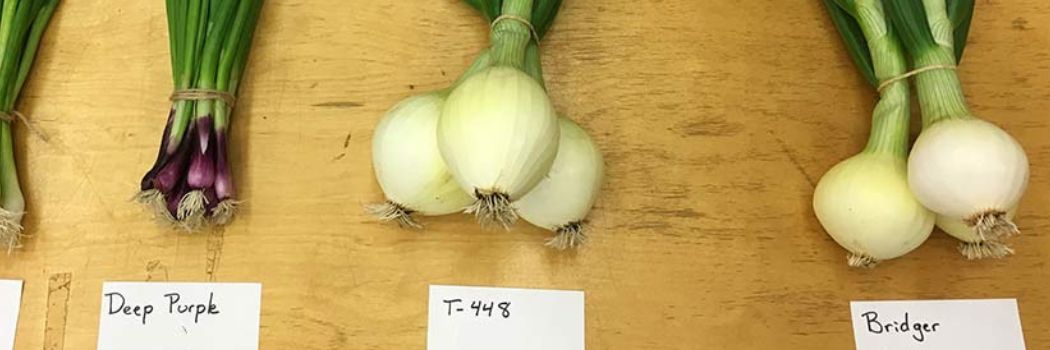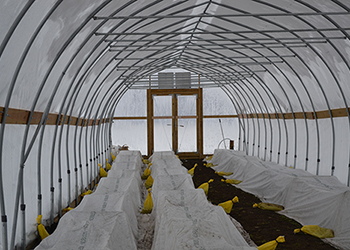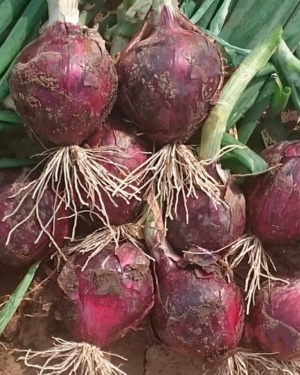- Onions - Instructions for Growing from Sets | Tech Sheet (PDF)
- Onion & Leek Production from Transplants | Tech Sheet (PDF)
- Pelleted Onions | Key Growing Information
- Onions | Key Growing Information
- Video: 4 Great Reasons to Grow 'Blush' Onion
- Overwintering Onions from Seed | Johnny's Selected Seeds
- Cipollini, Mini & Specialty Onions | Key Growing Information
- Full-Size Onion Varieties | Comparison Chart (PDF)
- Map of Long-Day, Intermediate-Day & Short-Day Onions
- Bunching Onions | Key Growing Information
- Winter Growing Guide | Part 6: Recommended Crops & Varieties
- Classic Storage Crops | Post-Harvest Handling & Storage Guidelines
- Onion Sets | Key Growing Information
Overwintering Onions for Spring Harvest
Recommendations from Johnny's Onion Overwintering Trials
Note
The recommendations here are based on recent overwintering trials conducted at our research farm in Albion, Maine (hardiness zone 5a).
Harvestability dates will vary. For best quality and yield in an overwintered onion crop, be sure to take your latitude and growing zone into account, adjusting dates and materials accordingly.
For more detail, see our Latitude & Daylength Map for long-, intermediate-, and short-day onions. Your local Cooperative Extension service can provide further guidance for your region.
Here in Maine, our summer-planted trials rapidly come to fruition as we transition into fall. But even as we evaluate and enjoy the season's bounty, we're readying for the first fall frost just a few short weeks away. As a four-season research farm, now's the time to get our winter-harvest and overwintering trials underway.
Each year we recalibrate and run new trials to study crops for harvesting over the course of the winter and into early spring. In the case of a recent overwinter trial, the results yielded plentiful data and a load of fresh, delicious, full-size onions by the end of May. This particular trial was housed in a 200-foot-long Gothic high tunnel on our research farm in Albion, but we also commonly overwinter onions in low tunnels. Here are the details on how we bring an onion trial through the Maine winter to a successful spring conclusion.
Sowing & Transplanting Goal: Onion Seedlings with 4–5 Leaves
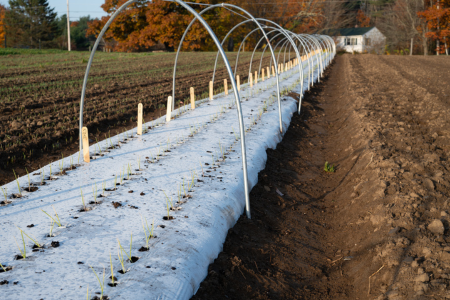
As is customary for us, this overwinter onion trial was sown in flats in the greenhouse on August 24, and the onion seedlings were transplanted into the Gothic high tunnel almost 5 weeks later, on October 3. For us as for most growers in long-day onion latitudes (37°–47°N), late August to early September is appropriate timing for sowing and late September to mid October for transplanting onions for overwintering.
As noted in the section of our Winter Growing Guide devoted to Recommended Crops & Varieties, the goal of this timing is to have the onion seedlings develop about 4–5 leaves before the hard freeze. (Some prefer to gauge them visually, to be "the size of a pencil" at this time, but we find leaf count to be a more reliable yardstick.) This is the level of maturity we aim for because if the plants are allowed to grow bigger before transplanting, they tend to bolt more easily come spring. And if they are not big enough, they will struggle to survive the coldest depths of winter, and may be slow to form bulbs in spring.
As elsewhere in market farming, diversification with overwintering onions can mitigate risk. Where practicable, you can hedge your bets by sowing and planting on a series of sequential dates as well as planting more than one variety, to help ensure a favorable outcome.
Falling Temperatures & Decreasing Day Length
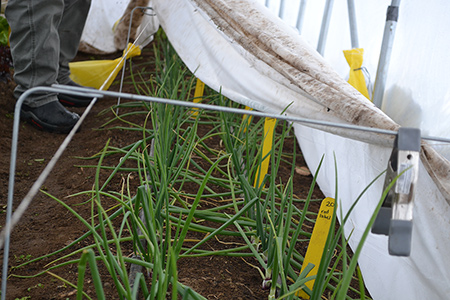
As October gave way to November and nighttime temperatures began to dip below freezing, we covered the plants with Agribon. We recommend heavy-weight row cover (Agribon+ AG-50 or Agribon+ AG-70).
On days when were still enjoying mild daytime highs, we removed the Agribon, so the plants would become incrementally acclimated to withstand the coldest temperatures of winter without being shocked. This process is similar to the process of hardening-off tender seedlings started indoors, before transplanting them out into the chilly, gusty conditions of spring, except that here, they are adapting to decreasing rather than increasing daylength and temperatures.
Air and soil temperatures continued to drop as we descended into winter, but the average daily soil temperature rarely fell below 30°F (-1°C), and the coldest recorded soil temperatures were about 27°F (-3°C). In the depths of January and February, the row cover stayed on all the time.
Lengthening Days + Rising Temperatures = Results!
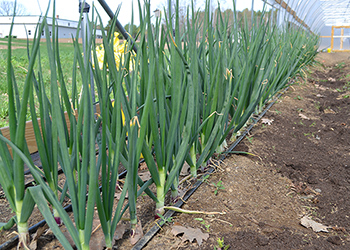
When spring and warmer temperatures arrived, we removed the row covers whenever air temperatures rose above freezing during the day, and for good once temperatures began to moderate.
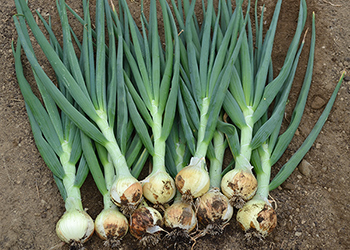
The plants began to grow again, and finally started to bulb-up in early to mid May.
Here is a combined summary of results from this particular overwinter trial, together with several subsequent onion overwintering trials:
Full-size White
- Though 'Bridger' was the clear winner of our early overwinter trials here in Albion, we have since found
'T-448' to be about a week earlier as an overwintered onion than 'Bridger,' with larger bulbs that are more rounded in shape. In addition, 'T-448' demonstrates exceptional bolt tolerance at this latitude when overwintered. For superior earliness, size, shape, and bolt tolerance, 'T-448' is therefore our #1 recommended full-size white onion for overwintering at higher latitudes. - For a spring-sown early onion, however, 'Bridger' is the better choice. When spring-sown, 'T-448' is not as early or as large as 'Bridger.'
Full-size Red
- 'Red Spring' has robust plants that survive winter well to form uniform, round, deeply red-pigmented bulbs. Growers familiar with 'Desert Sunrise' (dropped by our supplier) will find 'Red Spring' a suitable replacement that matures a few days later, is slightly more prone to bolting, and has more deeply red-pigmented bulbs. (As a long-day variety, 'Red Spring' also performs well as an early spring-sown red onion at higher latitudes, whereas 'Desert Sunrise' does not.)
Bunching Onions/Scallions
- Red: 'Deep Purple'
Full-size Yellow Onions from Sets
- Another opportunity to produce great spring onions is to start them from sets, as an adjunct to overwintering from seeds or the method of choice for those who do not have the time or labor to invest in onion seedling production. For growers of onion from sets at latitudes of 37° and higher, we recommend the classic 'Forum' onion.
- Timing is different for fall planting of onions from sets than it is for growing them from seed. We advise planting 'Forum' sets before the ground freezes, at around the same time as you would garlic or fall-planted flowering bulbs. Here in hardiness zone 5a, we plant ours mid-October through late November.
- A key advantage to planting onions from sets is that the planting time is more flexible. When growing from seed, you need to get the timing of the seeding right, and weather can throw things off—fall, winter, or spring. With 'Forum' you can toss the sets in ground and they will come up in spring like clockwork, typically producing onions approximately 2 weeks later than those you can obtain them from overwintered plants grown from seed.
- Because the harvest stage of 'Forum' onions from sets will be just that little bit later than onions overwintered from seeds, you can combine the two practices, staggering plantings in a way to ensure a sequential harvest. By the time the 'Forum' onions are done, you may even be able to begin bringing out your earliest spring-sown onions.
Common Problems with Overwintered Onions
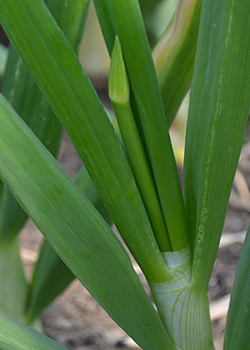
Overwintering crops is no simple endeavor, but if you have the market for these types of products, it can be a worthwhile. Here are some common problems that might be encountered in onions overwintering in a cold climate.
Bolting
Bolting is probably the most common problem to arise from overwintered onions, and it is one of the characteristics we watch closely in our overwinter trials.
Because onions are biennial, exposure of the overwintered plant to a cold snap in spring can signal that it is time to complete its lifecycle. In response to this environmental stressor it will send up a flower stalk, in an effort to produce seed for the next generation. To fuel this process the plant will draw sugars and other nutrients stored in the bulb, and a bolted plant will yield a bulb with a tough center and "off" coloration. The bulb will also stop enlarging, so you may also end up with a crop of smaller bulbs than is desired or marketable.
All onion varieties will eventually bolt after being overwintered. What's unique about the varieties we recommend for overwintering is that they are able to form a marketable bulb before they bolt. In addition to variety selection, success in overwintering depends largely on experimenting with seeding dates at your specific location. Plants will be more prone to early bolting come spring if they are too large or mature going into the winter. You can decrease the tendency to bolt by preventing large fluctuations in temperature within your growing environment through good ventilation. Finally, harvest the bulbs as soon as they are of marketable size.
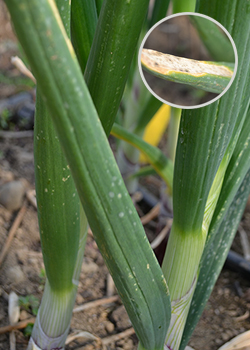
Botrytis Leaf Blight
Some onion varieties are very susceptible to botrytis, a disease is caused by the fungus Botrytis squamosa. It favors moist environments and initially shows up as small white spots or flecks on the leaves. As the disease progresses, the white lesions expand and the leaf will become sunken and brown, and eventually die (image inset).
Because botrytis thrives in humid conditions, ensuring that your tunnel is well ventilated and lowering the humidity around the plants by removing row covers as often as possible will help to prevent this disease.
Doubling or Splitting
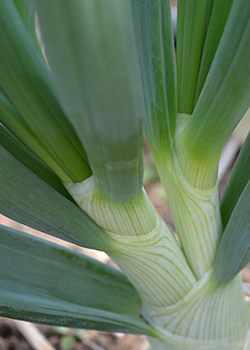
If any of your plants have split into two separate stalks, then you have a double bulb. While double bulbs are generally considered unmarketable, they are perfectly edible (even if they do require a little more prep time on the cutting board).
A number of factors can cause doubles, from the genetics of the variety to inconsistent watering, but environmentally, doubling is often the result of fluctuating temperatures—yet another reason to ensure good ventilation in your structure.
Small Bulbs
Onions require full sun, and anything less will result in small plants and in turn, small bulbs. The southeast side of our tunnel sits near an apple tree, which, while beautiful when covered by blossoms and later with apples, casts just a bit of shade on that corner of the tunnel. Plants from this portion of the tunnel are noticeably smaller than the plants in areas with full sun, so even a small amount of shade is something to consider.
When you are planting as the autumn leaves are falling, don't forget that they will be back in the spring and could shade your crop! Removing the row covers as much as conditions allow will also help expose the plants to more sunlight.
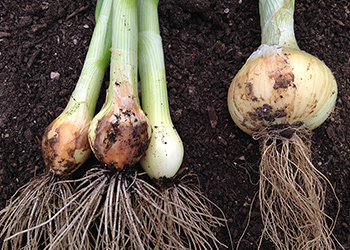
Death
As one would expect, not all varieties or even individual plants can withstand the extra stress of winter conditions, even with the extra protection from the elements that a tunnel environment affords them.
Perhaps it was simply too cold, or the bulbs were subjected to damage by rodents looking for a midwinter meal, or the plants weren't well established as they encountered dropping temperatures.
There are any number of reasons why some onions will not overwinter and ultimately die in the process. Sometimes it's for reasons within our control and sometimes not. Either way, because we look forward to another harvest of delicious onions in early spring, we'll be taking notes, making some adjustments, and trying again this coming year.
Learn More
If you are interested in reading more about cold-climate overwintering of onions, check out these reports from trials conducted in New Hampshire by Dr. Becky Sideman and colleagues.
- Production of Bulbing Onions Overwintered in New Hampshire with Protection by Low Tunnels • HortTechnology • Open-source Article
- Research Report: Overwintering Onions UNH Cooperative Extension • PDF


